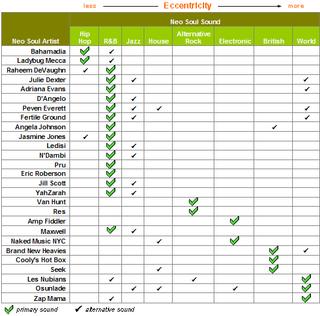New Artist Alert: Jasmine Jones
By Sean
Editor-in-Chief, Neo Soul Today
 Artist S/V Rating: R&B/Underground
Artist S/V Rating: R&B/Underground(What is this?)
It is difficult to discover a neo soul artist you've never heard of, heard, or seen before on iTunes. There is simply too much new and old music to search through. One can quickly grow tired of listening to one 20-second sample after another in search of something or someone new. Over the last 3 years, my first resort for finding new and emerging neo soul artists has been Liquid Soul Elements at Live365.com. When I had XM radio in my car, my second resort was The Flow on channel 61. However, on a regular basis, I still check iTunes to see if I happen to stumble upon a new neo soul artist, album, or song.
It was sometime around June 14, 2005. It was one of those times when I happened to be browsing through the R&B/Soul section of the iTunes Music Store. I wasn't looking for anything in particular; just checking to see if they had any new or emerging neo soul artists, albums, or songs. That night turned out to be my lucky night. There was an intriguing looking sister named Jasmine Jones exclusively billboarded atop the main R&B/Soul page featuring her newly-released album entitled "Battery Proper" (2005, Nickel City). So I proceeded to clickthrough to her album page to listen to some track samples. I was pleasantly impressed and surprised by what I heard; impressed enough to have had it in my rotation for a month and a half.

What immediately impressed me was the sheer sound quality of the tracks. There are many veteran neo soul artists whose song quality comes nowhere near that which was achieved on "Battery Proper." However, "intriguing" is the word that describes my first impressions of the independent Jasmine Jones' work on this album. Each track offers a completely different sound and flavor. Many of them I would place within the R&B sound category along the neo soul sound range. Yet, there are elements of hip hop beats that weave their way throughout the CD as well. Although Jasmine is just getting her career off the ground, my first impression is that she is a neo soul artist. However, it is too early to tell whether she'll ultimately be a neo soul artist or a contributing artist. She has a soft, unique voice with an apparently wide octave range. Her lyrics are easy to understand as she sings which makes the songs easier to experience.
"Battery Proper" has 15 tracks in total; all of which she wrote the lyrics for. Impressive for a first album. My overall favorite track is number 15 (Bonus Track) which is a reprise of track 6 (Everything) consisting simply of Jasmine's vocals and a piano paced by a rimshot, high hat, and bass drum to set the metronomic tempo. This song is nearly flawless. Listed below are all of my favorite tracks on the CD.
Audio Samples of My 8 Favorite Tracks
3. Detour Ahead
4. Brand New
6. Everything
9. My Prayer
10. Hold It
12. Sigh
13. Come On
15. Bonus Track
Admittedly, I only purchased and downloaded 8 of the 15 tracks from iTunes; which means that if I physically bought the CD from the store, I would be doing a considerable amount of track-skipping. Nevertheless, I'm more impressed with the fact that an independent neo soul artist's first-ever album has 15 tracks (with 8 of them still keeping the CD in the rotation). Given my stringent music tastes, this is a testament to the hard work and focus that went into making this CD.
As with any independent neo soul artist's first album, distribution of "Battery Proper" appears to be a challenge. As quickly as the album was featured on iTunes, it was no longer available there. Likewise, I find it surprising that the album isn't available at dustygroove.com or cdbaby.com, two of the world's major staples for purchasing independent neo soul music. The only legitimate outlet I found where the CD can be purchased is at amazon.com.
Jasmine Jones is definitely an emerging neo soul artist to watch. And if you're an early adopter like me, then we recommend that you purchase it today! You won't regret it.
 4.5 out of 5 stars
4.5 out of 5 starsFor more information on Jasmine Jones, visit:
Nickel City Music
Purchase and download Battery Proper tracks at emusic.com
Artist Profile for Jasmine Jones at music-mp3.net
We welcome your comments.




